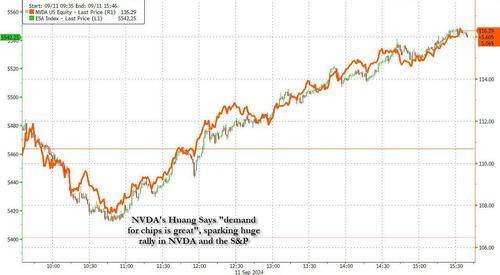Uddrag fra Goldman/ Zerohedge:
To say that the highly anticipated presentation by NVDA CEO Jensen Huang had a market impact, would be an understatment: not only did Huang’s comments spark a $250 billion surge in NVDA’s market cap, he also managed to turn around a nearly 2% drop in the S&P and make it into a 1% gain…
… he also transformed the Nasdaq’s early 1% slide in the the S&P and made it into a 2% bounce, something which as the next chart shows, happens only at very “special” times for the market.
So what exactly did he say? Well, we already highlighted some of the market moving detail, but here, courtesy of Goldman TMT specialist Peter Callahan, is the full story (much more in the full notes available for pro subs, here and here):
Couple soundbites from the NVDA session
NVDA detailed that Moore’s Law was no longer delivering the rate of innovation it had in the past and, as such, was driving computation inflation in Data Centers. Further, he noted that the densification and acceleration of the $1 trillion data center infrastructure installed base alone would drive growth over the next 10 years, as it would deliver material performance improvement and/or cost savings .
On the topic of Generative AI, NVDA/Jensen articulated that generative AI isn’t a tool, it’s a skill, which is why some people believe AI will expand beyond the trillion dollars of datacenters and IT and into the world of skills (e.g. digital chauffeur / autonomous or digital assembly line worker, etc).
in terms of ROIs, from a revenue generation perspective, Mr. Huang shared that hyperscale customers can generate $5 in rental revenue for every $1 spent on Nvidia’s infrastructure, given sustained strength in the demand for accelerated computing .. at a practical level, NVDA noted that while using a GPU to augment a CPU will drive an increase in cost in absolute terms (~2x) in the case of Spark (distributed processing system and analytics engine for big data), the net cost benefit could be as large as ~10x for an application like Spark given the speed up of ~20x
NVDA/Jensen reiterated that the company will begin shipping Blackwell-based products in FY4Q25 and that shipments will scale in FY2026. He also stated that demand is strong and that he feels a sense of responsibility given the company’s position as the key provider to essentially all CSPs (+ other companies) developing AI.
When describing the company’s competitive moat, Mr. Huang highlighted the company’s a) large installed base of GPUs across multiple platforms (with backward/forward software compatibility), b) ability to augment their hardware with software (e.g., domain-specific libraries), and c) ability to build rack-level systems and innovate across various chips (Nvidia designs 7 chips for the Blackwell platform).
And here are the Key Takeaways from Goldman’s research analyst covering NVDA, Toshiya Hari:
- Accelerated Computing: Mr. Huang highlighted his long-held view that Moore’s Law was no longer delivering the rate of innovation it had in the past and, as such, was driving computation inflation in Data Centers. Further, he noted that the densification and acceleration of the $1 trillion data center infrastructure installed base alone would drive growth over the next 10 years, as it would deliver material performance improvement and/or cost savings.
- Customer ROI: Mr. Huang noted that we have hit the end of transistor scaling that enabled better utilization rates and cost reductions in the previous virtualization and cloud computing cycles. He explained that, while using a GPU to augment a CPU will drive an increase in cost in absolute terms (~2x) in the case of Spark (distributed processing system and analytics engine for big data), the net cost benefit could be as large as ~10x for an application like Spark given the speed up of ~20x. From a revenue generation perspective, Mr. Huang shared that hyperscale customers can generate $5 in rental revenue for every $1 spent on Nvidia’s infrastructure, given sustained strength in the demand for accelerated computing.
- Competitive moat: When describing the company’s competitive moat, Mr. Huang highlighted the company’s a) large installed base of GPUs across multiple platforms (with backward/forward software compatibility), b) ability to augment their hardware with software (e.g., domain-specific libraries), and c) ability to build rack-level systems and innovate across various chips (Nvidia designs 7 chips for the Blackwell platform).
- Thoughts on supply chain: Mr. Huang spoke to its supply chain partners’ agility. He noted that without the help of its partners, including key suppliers like TSMC, the company would not have been able to deliver the hockey stick-like revenue growth in 2H23/2024. That said, he did note that Nvidia has adequate in-house Intellectual Property to shift manufacturing without material disruption should they be required to do so.
- Reiterated Blackwell schedule: Mr. Huang reiterated that the company will begin shipping Blackwell-based products in FY4Q25 and that shipments will scale in FY2026. He also stated that demand is strong and that he feels a sense of responsibility given the company’s position as the key provider to essentially all CSPs (+ other companies) developing AI.



